In this review we talk about Potions and Herbalists, a compendium (without a reference system) of new options for concoctions that grant powers out of the ordinary.
We thank Diego Pisa Artworks for providing us with a review copy of the manual. We recommend that you follow him on his Facebook, Instagram and Patreon pages to stay informed about his fantastic projects.
You can buy an hardcover copy of Potions and Herbalists for 24 euros on DriveTrhuRPG. Otherwise it is available in softcover version for 13 euros on the same site; or you can also purchase the digital version for 8 euros.
Potions and Herbalists Structure Review
The manual has a very appealing design; it is in A4 format and is rich in content (70 pages). The cover is durable and the rough, brown paper gives a pleasant parchment effect.
Potions and Herbalists opens with list of the various potions and ingredients, indicating in which pages they can be found, and then we can find the actual index. The manual is divided into 12 chapters and we can find both new potions and options for herbal medicine.
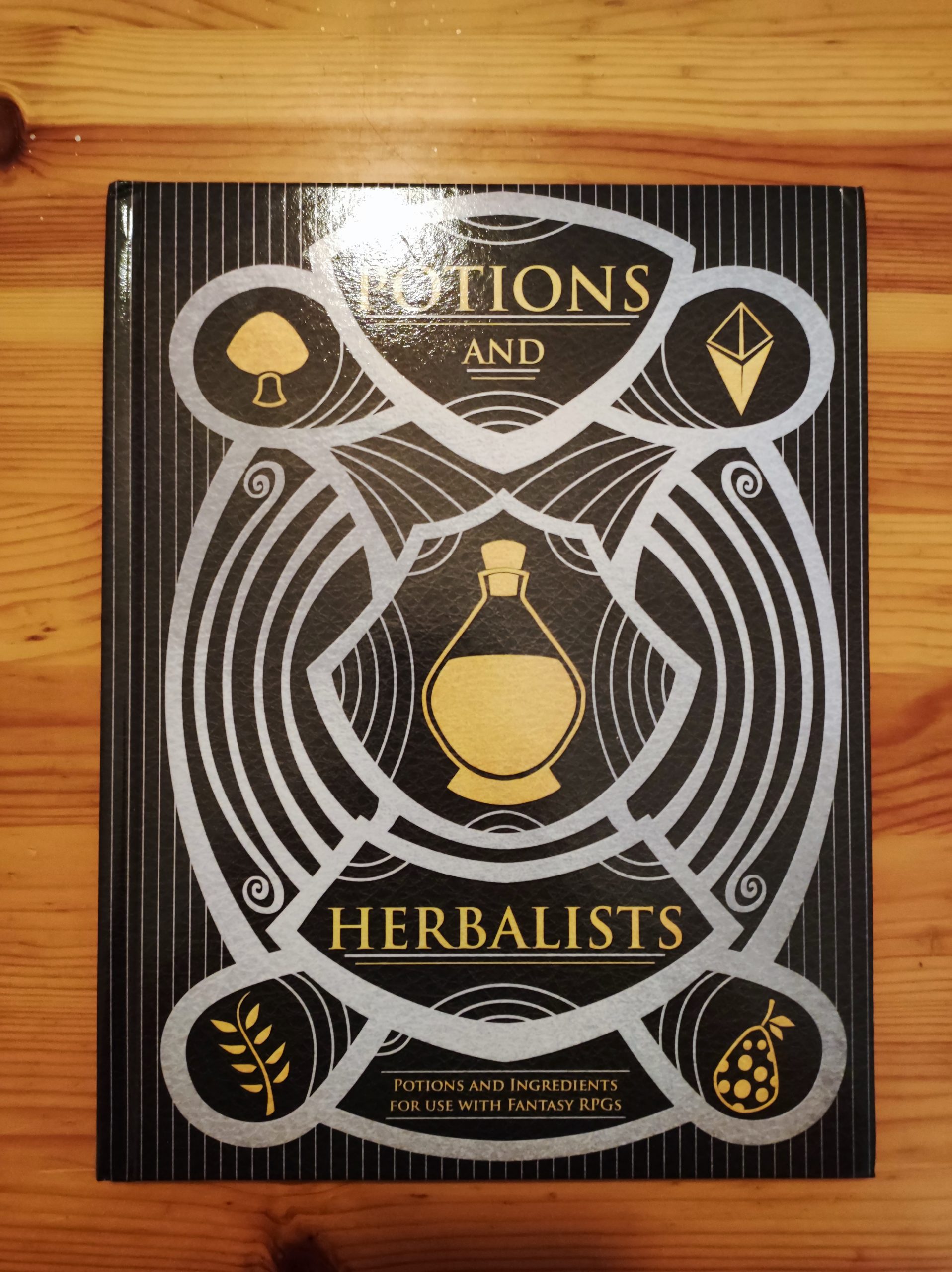
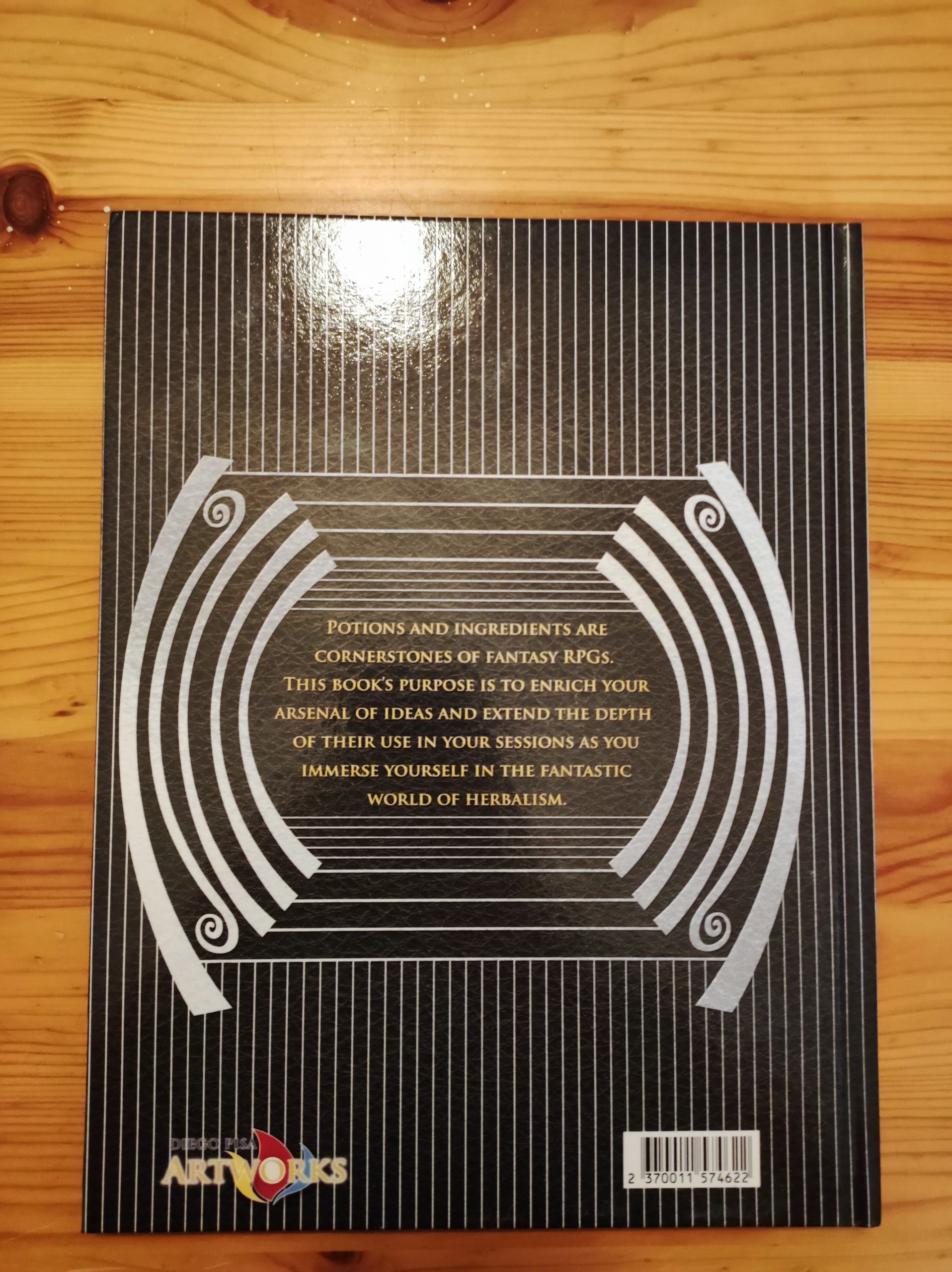
The writing style is clear, simple and straight to the point; all the explanations are well organized and very understandable. I reallu appreciated the boxes that illustrate how to insert the elements presented in your sessions. Moreover this manual is not created for a specific game system; this allows you to exploit it with any fantasy roleplaying game without particular constraints.
Potions and Art
Potions and Herbalists is aesthetically magnificent. All the illustrations are amazing and themed with the content; the style makes them appear as if they were drawn by hand directly on paper. The parchment colored paper further intensifies this wonderful feeling.
In addition, all the portraits of the NPCs presented are also particular and evocative, maintaining a coherence with the rest of the manual; together with the illustrations of the potions, they are one of the aspects that I most appreciated.
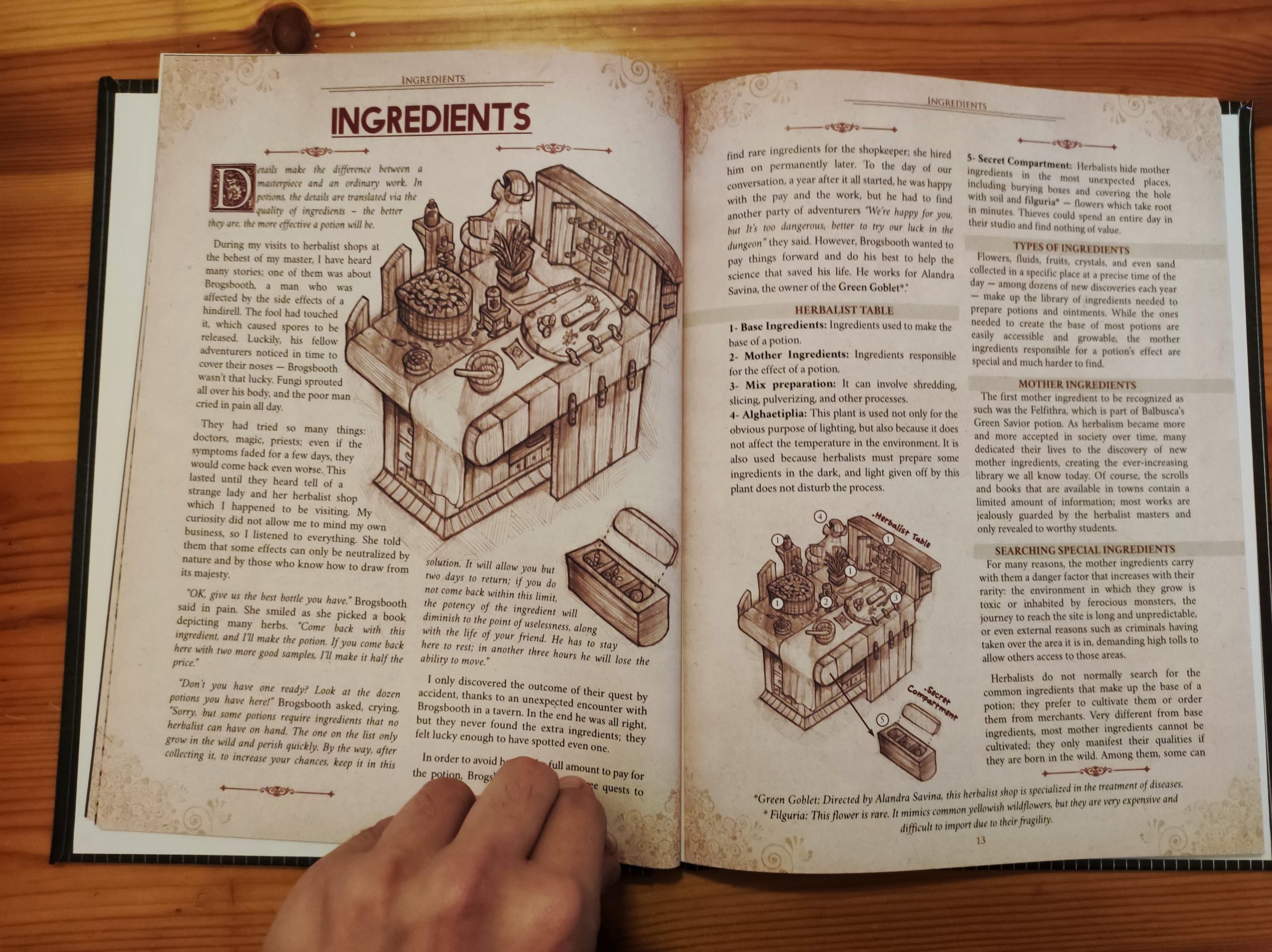

Potions and Herbalists also shows a perfect palette of colors that makes reading very enjoyable. In the text there are bold, italics and other tricks that further make reading easy.
In short, from an artistic and graphic point of view, the manual is a jewel!
Practical Guide to the Use of Potions
The first chapter of the manual contains an introduction of the material and how to use it.
Then continue with a insight into herbalism, its history and its ethical code: the “green code”; the information offers excellent ideas to add particular elements to your campaign. We also find a large box where there are options to include herbal medicine in your game.
All the methods are interesting and guarantee these possibilities to the NPCs or even to the PCs, analyzing the pros and cons. In case you want to create potions for the player characters, it is explained how to balance the option and make it intriguing.
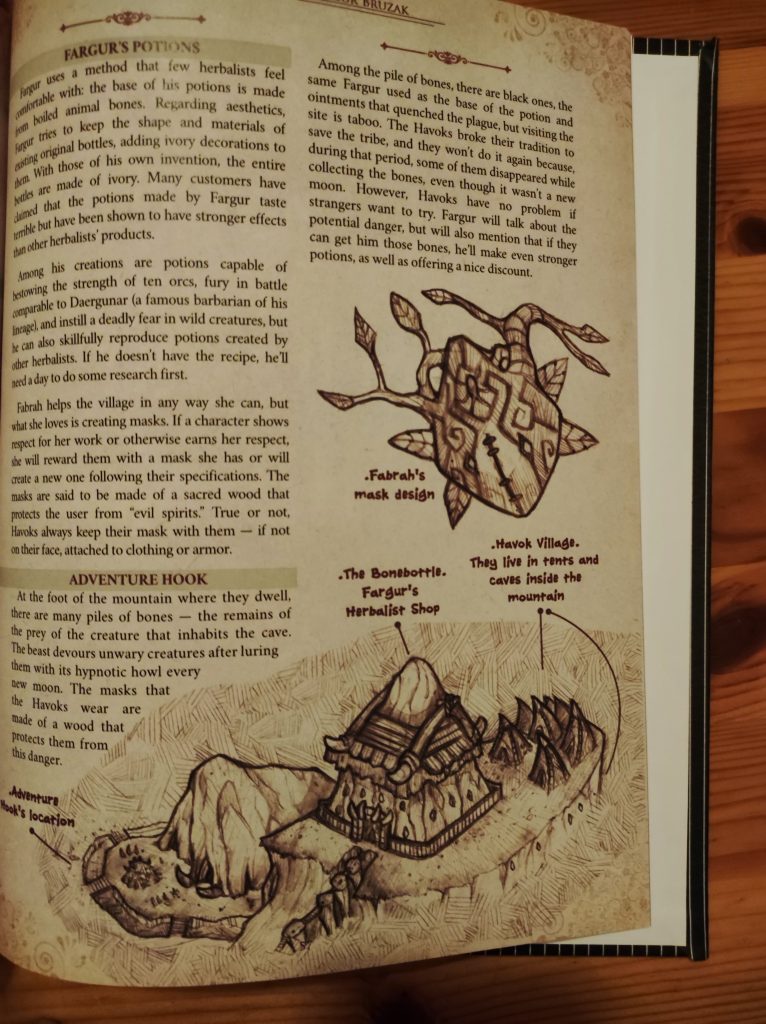

Ingredients are also discussed in depth; each of them has its own history and characteristics.
There are also tips and ideas on how to create side quests (or campaigns) focused on finding ingredients. In the usual box we find indications on how to manage them mechanically and on how to distribute them in a different way in the world map. In this regard, a sample map is provided and you can use it or draw inspiration from it.
Review of the New Potions
In Potions and Herbalits we find 20 new potions with unique effects and in this review I will illustrate some of them; mechanically they are all extremely particular and will add unpredictability to your sessions.
Each potion is presented with a description of the bottle and the liquid, a short paragraph with its history, effect, side effects and necessary ingredients. The descriptions are all captivating and involve all five senses; even their stories are intriguing and can provide valuable narrative cues. To avoid falling into repetitiveness, there are really unexpected side effects.

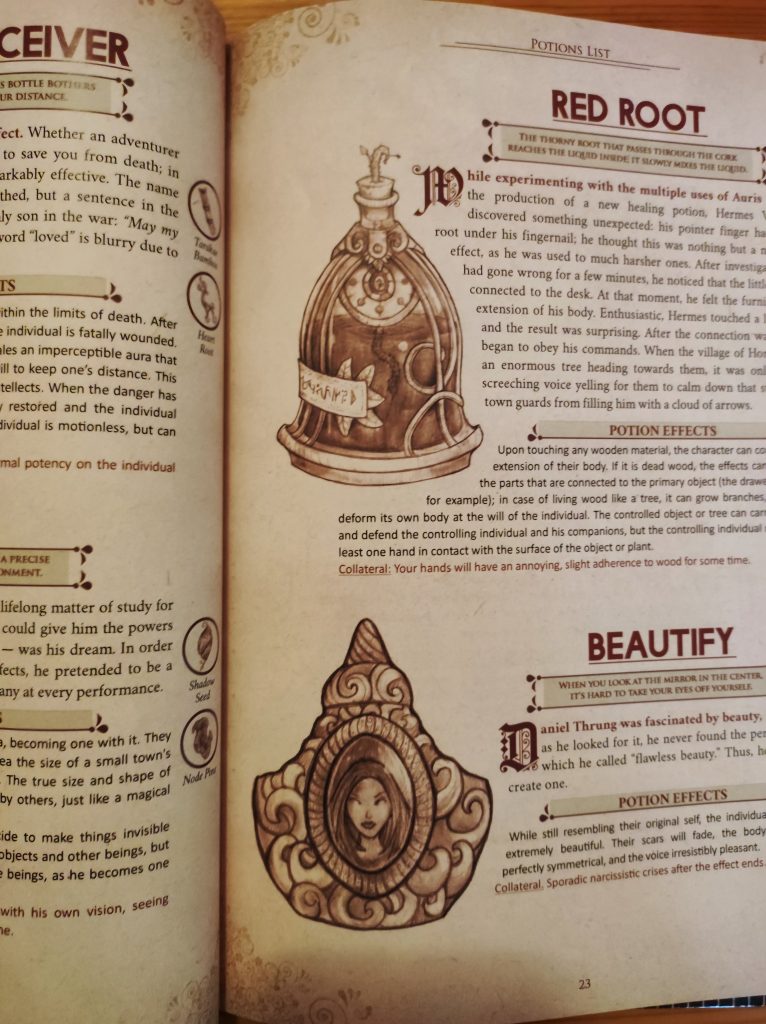

Among the potions that I preferred we find:
- Red Root: a bottle wrapped in a root that reaches the liquid from the cap and slowly mixes it; anyone who drinks it can control the wood as if it were an extension of their body.
- Eye of The Finder: glass container with a rotating sphere in the center that follows those close to it. This potion allows you to recall someone’s remembrance, even if you only have a few faint bits of memory about they.
- Time Fragment: the clock in the center of the potion does not indicate the current time, but has strange symbols that indicate months, years and days. Those who drink this potion will be able to influence, in a reduced way, the passage of time.
- Bite of Life: a fragile-looking glass bottle, with a needle at the bottom; unlike many other concoctions, it is not drunk but injected; it is very powerful because it can cure any disease, but it is also very rare.
In addition to these, there are many others with original and unexpected effects. The effect is not just narrative, but also gives advice on how to best include it in your sessions.
Potions and Herbalists New Ingredients Review
In addition to the potions, we find many other new ingredients made specifically to expand the options for herbal medicine. The ingredients are more than 40, thus offering a large amount of combinations.
Each Ingredient is presented with its own description, where to find it and the precautions to collect it. In fact, these aspects are not trivial and can easily generate deep and compelling side missions.



Some of the new ingredients are:
- Shadow Seed: a seed that works in reverse; instead of looking for light, it searches for darkness and releases a pheromone that makes the area around it completely dark. You have to be careful to pick it up because due to the dark area hallucinations may occur or worse.
- Testament Leaf: the last leaf of a dying tree that has never touched the ground, with a unique pattern; it is a complex ingredient to find and those who will get it will feel continuously observed for three days.
- Time Crystal Shard: : the fragment of a very rare crystal; inside there is a constellation that changes continuously. When you go looking for them you have to be careful because if you observe it you could lose yourself in the constellation, risking being stuck forever.
- Link Stone: two rocks that are magnetically attracted to each other but not physically connected. The stones used to reunite two close people or locate someone when they are very far away.
In addition to these ones, we find many others very interesting and particular; surely they can be a great addition to your sessions. Moreover we also find a box with the explanation on how to create your own ingredients, granting full freedom.
The Herbalists
The last chapter allows us to enter the world of herbalists.
First of all, the basic notions related to herbalist’s shops are presented, such as the division into rooms and the essential furniture. There are also suggestions on how to make a store the starting point for a campaign and how to create NPCs related to it.
Then the Master Herbalists are introduced; they are two specialists in their field, ready to be included in your campaigns. Both are presented with a portrait, their main info, how their potions work, where their store is located and also adventure hooks. The two scholars are:
- Flora Willdom, a human plant lover; the design of her potions is linked to the plant world and her shop also respects these characteristics. She often asks the brave adventurers who visit her to find exotic plants to use in her lab.
- Fargur Bruzak, one of the favorite ingredients of this herbalist ogre are the bones and the design of the potions is very simple but with ivory veins. His shop is in the mountains and has a simple appearance; if the adventurers bring him particular bones, he exploits them in order to create powerful potions.

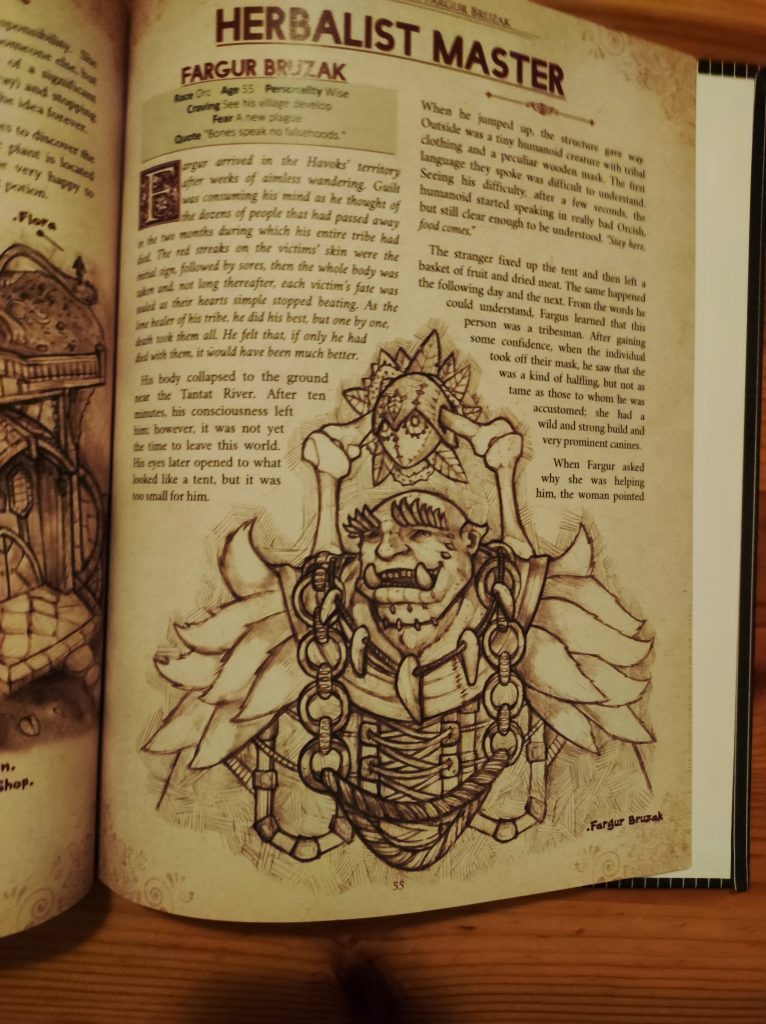
These NPCs are very interesting and can break the linearity of any adventure.
The Herbalist’s Tools
Finally, we find the key tools for an herbalist. From scissors to the recipe book, passing through everything you need to store in an herbalist’s backpack. There are multiple types of backpacks and also options on how to use them in your games; for example, finding a backpack in the wild could be the beginning of an adventure.
Another important element is the carriage, the means by which herbalists transport their precious belongings. There are also random encounters in which adventurers cross one of these means.
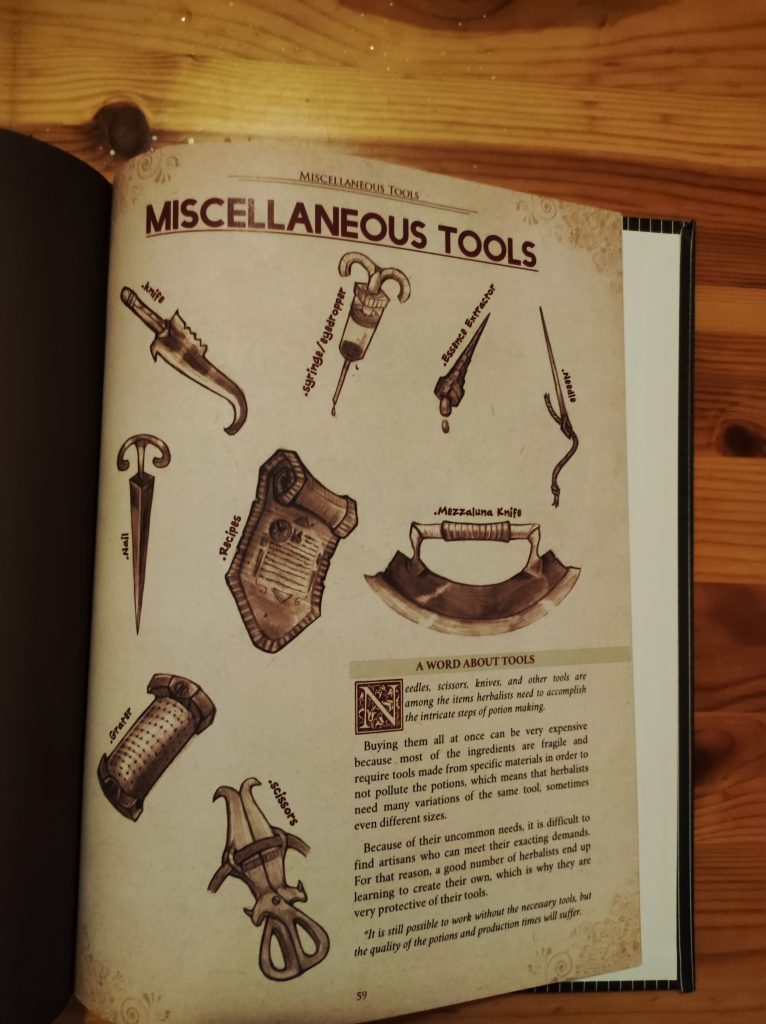

Your heart will melt when you will see the companions of the herbalists; they are all versatile and special, so much that they could also be used as familiars. I personally adored the Tortobas, turtles that can grow a particular type of plants on their shells.
Potions and Herbalists Review Conclusions
To conclude my review of Potions and Herbalists, I can say that it is a thematic manual, full of options that expand the imagination of the classic fantasy roleplaying games.
In addition to this, the graphic aspect is incredible; starting from the artwork to the layout, this is another reason to have this manual in your library!

